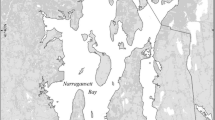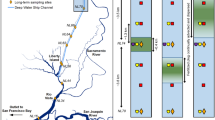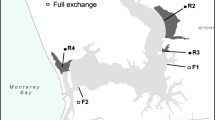Abstract
A tandem deployment system was used to critically evaluate relationships between important water chemistry parameters (pH, salinity, dissolved oxygen) and biotic performance based on clam growth. The effects of environmental conditions on growth of juvenile clams,Mercenaria mercenaria, were determined after 7-day field deployments in cages at reference sites from 1998 to 2000. Continuous measurements of the overlying water chemistry parameters were monitored by deploying an in situ water quality instrument (Hydrolab Datasonde) at the same time. While salinity was identified as an important determinant of clam growth over wide salinity ranges (10–35‰), pH was also found to be a very important parameter, especially in low-salinity regimes (<25‰). Average pH measurements ranged from 7.2 to 7.8; minimal pHs ranged from 6.9 to 7.6. The results indicated that when average pH levels fell below 7.5 or minimum pH levels fell below 7.2, growth rates were <50% that of clams deployed under higher pH conditions. Estuarine systems are generally perceived as being well-buffered so pH is frequently assumed to be unimportant, but our results suggest that pH levels can decline in estuarine systems to levels that can adversely affect biological responses. The potential impacts on biological resources of even moderate decreases in pH, particularly in systems that naturally tend to have lower pH conditions, may be more important than previously realized.
Similar content being viewed by others
Literature Cited
Bamber, R. N. 1987. The effects of acidic sea water on young carpet-shell clamsVenerupis decussata (L.) (Mollusca: Veneracea).Journal of Experimental Marine Biology and Ecology 108:241–260.
Bamber, R. N. 1990. The effects of acidic seawater on three species of lamellibranch mollusc.Journal of Experimental Marine Biology and Ecology 143:181–191.
Bayne, B. L., D. A. Brown, K. Burns, D. R. Dixon, A. Ivanovici, D. R. Livingstone, D. M. Lowe, M. N. Moore, A. R. D. Stebbing, andJ. Widdows 1985. The Effects of Stress and Pollution on Marine Animals. Praeger Scientific Press, New York.
Beck, N. G. andK. W. Bruland. 2000. Diel biogeochemical cycling in a hyperventilating shallow estuarine environment.Estuaries 23:177–187.
Booth, C. E., D. G. McDonald, andP. J. Walsh. 1984. Acidbase in the sea mussel,Mytilus edulis. I. Effects of hyperoxia and air-exposure on hemolymph acid-base status.Marine Biology Letters 5:347–358.
Calabrese, A., andH. C. Davis. 1966. The pH tolerance of embryos and larvae ofMercenaria mercenaria andCrassostrea virginica.Biological Bulletin 131:427–436.
Chapman, P. M. andF. Wang. 2001. Assessing sediment contamination in estuaries.Environmental Toxicology and Chemistry 20: 3–22.
Dwyer, III,J. J. andL. E. Burnett. 1996. Acid-base status of the oysterCrassostrea virginica in response to air exposure and to infections byPerkinsus marinus.Biological Bulletin 190:139–147.
Grizzie, R. E. andP. J. Morin. 1989. Effect of tidal currents, seston, and bottom sediments on growth ofMercenaria mercenaria: Results of a field experiment.Marine Biology 102:85–93.
Harris, J. O., G. B. Maguire, S. J. Edwards, andS. M. Hindrum. 1999. Effect of pH on growth rate, oxygen consumption rate, and histopathology of gill and kidney tissue for juvenile greenlip abalone,Haliotis laevigata Dononvan and blacklip abalone,Haliotis rubra Leach.Journal of Shellfish Research 18:611–619.
Hubertz, E. D. andL. B. Cahoon. 1999. Short-term variability of water quality parameters in two shallow estuaries of North Carolina.Estuaries 22:814–823.
Knezovich, J. P. 1994. Chemical and biological factors affecting bioavailability of contaminants in seawater, p. 23–38.In J. L. Hamelink, P. F. Landrum, H. L. Bergman, and W. H. Benson (eds.), Bioavailability: Physical, Chemical, and Biological Interactions. Lewis Publishers, Boca Raton, Florida.
Lindinger, M. I., D. J. Lauren, andD. G. McDonald. 1984. Acid-base balance in the sea mussel,Mytilus edulis. III. Effects of environmental hypercapnia on intra- and extracellular acid-base balance.Marine Biology Letters 5:371–381.
Nuccitelli, R. andD. W. Deamer. 1982. Intracellular pH: Its Measurement, Regulation and Utilization in Cellular Functions. Alan R. Liss. Inc., New York.
Rabalais, N. N., W. J. Wiseman, andR. E. Turner. 1994. Comparison of continuous records of near-bottom dissolved oxygen from the hypoxia zone along the Louisiana coast.Estuaries 17:850–861.
Rice, M. A. andJ. A. Pechenik. 1992. A review of the factors influencing the growth of the northern quahog.Mercenaria mercenaria (Linnaeus, 1758).Journal of Shellfish Research 11: 279–287.
Ringwood, A. H. 1992. Effects of chronic cadmium exposures on growth of larvae of an Hawaiian bivalve,Isognomon californicum.Marine Ecology Progress Series 83:63–70.
Ringwood, A. H., A. F. Holland, R. Kneib, andP. Ross. 1996. EMAP/NS&T pilot studies in the Carolinian province: Indicator testing and evaluation in southeastern estuaries. NOAA Technical Memorandum NOS ORCA 102. National Oceanic and Atmospheric Administration, Silver Spring, Maryland.
Ringwood, A. H. andC. J. Keppler. 1998. Seed clam growth: A sediment bioassay developed in the EMAP Carolinian province.Environmental Monitoring and Assessment 51:247–257.
Salazar, M. H. andS. M. Salazar. 1991. Assessing site-specific effects of TBT contamination with mussel growth rates.Marine Environmental Research 32:131–150.
Van Dolah, R. F., J. L. Hyland, A. F. Holland, J. S. Rosen, andT. R. Snoots. 1999. A benthic index of biological integrity for assessing habitat quality in estuaries of the southeastern USA.Marine Environmental Research 48:269–284.
Walsh, P. J., D. G. McDonald, andC. E. Booth. 1984. Acid-base balance in the sea mussel,Mytilus edulis. II. Effects of hypoxia and air-exposure on intracellular acid-base balance.Marine Biology Letters 5:359–369.
Weisberg, S. B., J. A. Ranasinghe, D. M. Dauer, L. C. Schaffner, R. J. Diaz, andJ. B. Frithsen. 1997. An estuarine benthic indes of biotic integrity (B-IBI) for Chesapeake Bay.Estuaries 20:149–158.
Wenner, E. L. andM. Geist. 2001. The National Estuarine Research Reserves program to monitor and preserve estuarine waters.Coastal Management 29:1–17.
Widdows, J., P. Donkin, M. D. Brinsley, S. V. Evans, P. N. Salkeld, A. Franklin, R. J. Law, andM. J. Waldock. 1995. Scope for growth and contaminant levels in North Sea mussels.Mytilus edulis.Marine Ecology Progress Series 127:131–148.
Author information
Authors and Affiliations
Corresponding author
Rights and permissions
About this article
Cite this article
Ringwood, A.H., Keppler, C.J. Water quality variation and clam growth: Is pH really a non-issue in estuaries?. Estuaries 25, 901–907 (2002). https://doi.org/10.1007/BF02691338
Received:
Accepted:
Issue Date:
DOI: https://doi.org/10.1007/BF02691338




